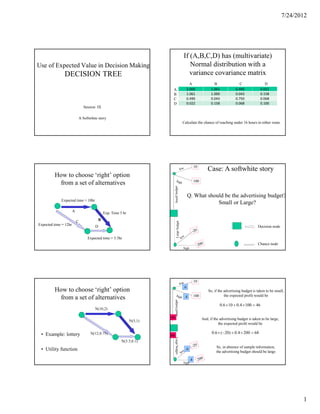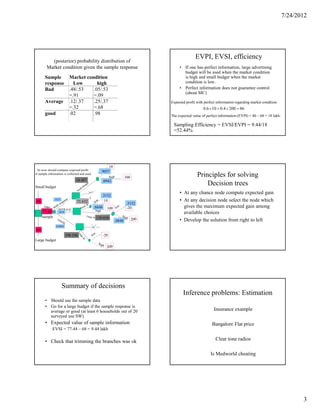The document discusses using expected value in decision making and provides an example using a decision tree. It shows a scenario where an advertising budget can be small or large. If small, the expected profit is 46. If large, the expected profit is 68. Therefore, without sample information, the large budget should be chosen. The document then discusses taking a sample to get more information before making the decision.

![7/24/2012
10 10
100 P[‘LOW’ market condition given
100
-20 that sample response is BAD] ?
200
Large budget
P[market condition is low] = 0.6
Take
P[BAD sample response given ‘LOW’ market condition]
sample
10 10
Binomial Distribution
100
100 low high
0.2 0.4 values
0.0115 0.0000 0 0.8042 0.1256 If the market condition is high
0.0576 0.0005 1
0.1369 0.0031 2
(40% of the users will buy SW),
L
0.2054 0.0123 3 what is the chance of 8 out of
0.2182 0.0350 4
0.1746 0.0746 5 the 20 randomly chosen HH
Take
0.1091 0.1244 6 0.1932 0.6297 purchasing SW?
0.0545 0.1659 7
0.0222 0.1797 8
0.0074 0.1597 9
20
sample 0.0020 0.1171 10 0.0026 0.2447 C 8 ×0.408 × 0.6012 = 0.1797
0.0005 0.0710 11
0.0001 0.0355 12
0.0000 0.0146 13
0.0000 0.0049 14
0.0000 0.0013 15
0.0000 0.0003 16
0.0000 0.0000 17
0.0000 0.0000 18
0.0000 0.0000 19
0.0000 0.0000 20
10
So now should compute expected profit .6? Probability through Venn Diagram
if sample information is collected and used
100
0.4 ×1256=0.05
Small budget
L
46 0.60×.8042=0.48
BAD 0.25
Take
AVERAGE
sample
0.10
68 0.60 ×0.1932=0.12
GOOD
Large budget
Low High
2](https://image.slidesharecdn.com/session910-121004052621-phpapp02/85/Session-9-10-2-320.jpg)


